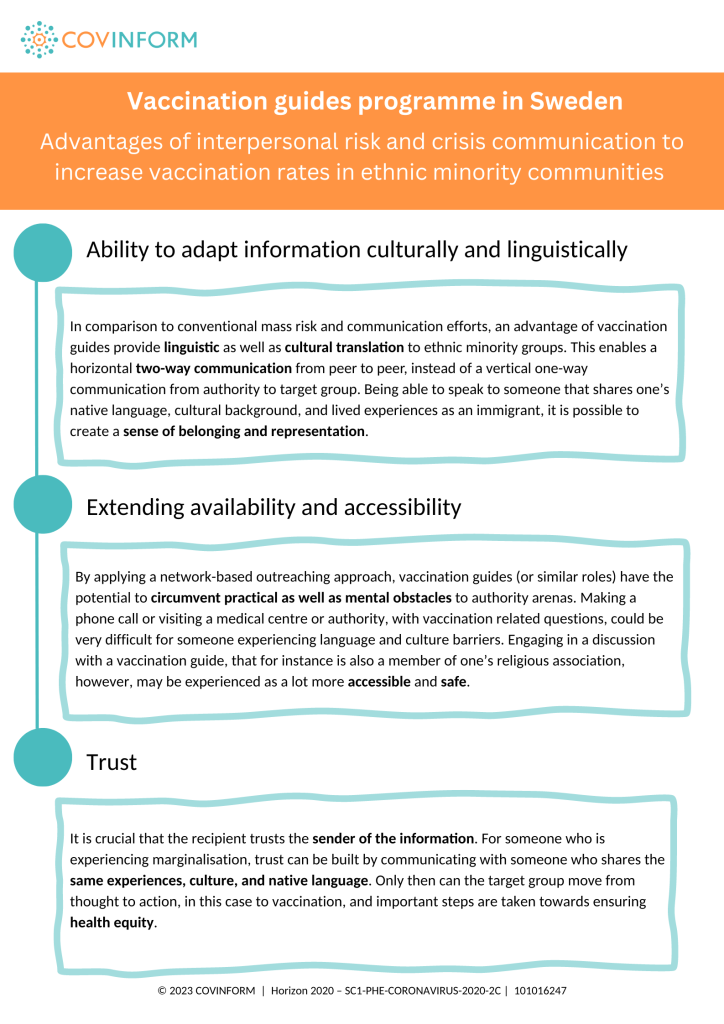
23 Jan “Bridging the gap”: The importance of interpersonal risk and crisis communication
In the autumn of 2021, the Swedish COVID-19 vaccination roll-out was in full progress and vaccines had become available for all Swedish adults. Although there was a sufficient vaccine supply, it became increasingly evident that the vaccination rates were significantly lower among populations of foreign-born individuals living in areas with socio-economic challenges. The so-called vaccination guide project was launched in the city of Gothenburg – a network-based risk and crisis communication initiative, aiming to increase vaccination rates in ethnic minority communities. Vaccination guides refer to people working in ethnic minority communities, talking and connecting with people to inform them about COVID-19 vaccines.
In September of 2021, the Swedish Public Health Agency made its first extensive conclusion of the national vaccination rates, presenting statistics down to the city district level. The statistics revealed that the Northeast area of Gothenburg had the lowest vaccination rates in the country. The Northeast is considered an area with households of low socio-economic status and a large part of its population being born outside of Sweden. The two largest language groups, apart from Swedish, are Somali and Arabic (Kudo & Palm, 2021; Swedish Public Health Agency, 2021a; Swedish Public Health Agency, 2021b).
At that point in time, while practically all residents in other districts a few kilometres away had received two doses of vaccine, some areas of the Northeast had vaccination rates as low as 36 per cent for the first dose and 23 per cent for the second. The statistics made Gothenburg the most segregated city in Sweden in terms of vaccination rates (Kudo & Palm, 2021). However, Sweden was far from unique in terms of this phenomenon; similar accounts on low vaccination rates, related socio-economic aspects and immigrant background, soon came from, among others, neighbouring Scandinavian countries, the U.S., and the U.K (Brekke, 2021; Chou, Burgdorf & Gaysynsky, 2020; Díaz et al., 2021; Kamal, Hodson & Pierce, 2021). These are worrying statistics since equal vaccine uptake must be considered pivotal in order to ensure health equity.
This blog will explore the barriers between mass risk and crisis communication – in this case, vaccination information – and hard-to-vaccinate immigrants, and how interpersonal approaches may be a crucial solution to bridge this gap, using the example of the vaccination guide project in Gothenburg.
Identifying the barriers
There are a number of interplaying factors that may affect the efficiency of conventional mass risk and crisis communication, such as vaccination information, to hard-to-vaccinate immigrant individuals:
- Language barriers: can create challenges in accessing correct information about vaccines and their potential.
- Low health literacy and/or low level of education: may cause difficulties in obtaining health-related information.
- Disbelief in the legitimacy and well-intentions of society and its institutions (healthcare, media, politics): this distrust may result from encountering false/conflicting information, experiencing discrimination in the new home country, etc. Therefore, one may resort to alternative sources of information e.g. from personal contacts, social media or alternative news media, which results in increased exposure to disinformation.
Introducing the vaccination guide project
The vaccination guide project was launched as a joint initiative between the municipal office of the city of Gothenburg and the regional office of Region Västra Götaland. The project was built upon already existing communication projects with local civil society actors providing health information in ethnic communities in Gothenburg. Since the so-called vaccination guides are individuals who are part of the communities they are working in, they share native languages, cultural backgrounds, and lived experiences. Since Arabic and Somali are the dominating languages in the Northeast, those are subsequently the two largest language and culture groups among the vaccination guides. The aim was to provide vaccination information, linguistically and culturally tailored to hard-to-vaccinate immigrants, through trusted key individuals sharing the same network. The main notion was to convey information and create a trusted relationship, rather than persuading. Departing from mainly an outreaching approach, the vaccination guides visited natural local meeting places, such as bus stops, grocery stores or squares, and engaged in conversation about vaccination. The guides also visited places relevant to their own networks, such as religious associations or networking groups for mothers.
During the project’s time period, 80 guides worked a total of 5568 hours to communicate immunisation information to ethnic minority communities. In the months following the launching of the vaccination guide project, the area of Northeast increased the most in terms of vaccination rates. The targeted and tailored communication efforts are most likely pivotal aspects in terms of this increase
Interpersonal communication – a crucial complement to risk and communication efforts
The vaccination guide approach has many advantages and possesses the potential to work as a crucial complement to conventional mass risk and crisis communication efforts. Previous research argues that drawing on existing networks and civil society actors is a useful approach to reaching ethnic minority groups with risk and crisis communication (see e.g. Brekke, 2021; Kamal et al., 2021; Wieland et al., 2021). By identifying trusted key individuals that share networks with the target groups, and by strategically departing from these networks to spread information about vaccination, many of the aforementioned barriers may be bridged.
Through the interviews conducted with vaccination guides in spring 2022, it was argued time and time again that it does not matter if the correct information is communicated in an understandable way if the source, or the information itself, is not trusted. The challenge, therefore, consists partly in adapting, packaging and conveying information that the said target group understands. And partly, the challenge consists in providing information from a trusted source. Only then can the target group move from thought to action, in this case to vaccination, and important steps are taken towards ensuring health equity.

Being a part of defining the challenges – and being the solution
Authorities as well as regional and local governing offices have a lot to learn from civil society, and vice versa. The city of Gothenburg and Region Västra Götaland strategically planned and implemented an interpersonal risk and communication project that was, in many ways, completely performed “by the book”, according to model procedures suggested in risk and crisis communication research on how to reach ethnic minorities in times of crisis (see e.g. Brekke, 2021; Brosius & Weimann, 1996; Heath, 2010; Kamal et al., 2021; Seeger & Sellnow, 2013; Weimann, 1982). The vaccination guides themselves took on a great level of personal responsibility, working many hours to effectively communicate the importance of getting vaccinated. Interpersonal efforts proved to be an important complement when conventional communication was not nearly enough.
Through an interpersonal approach, governing instances can allow people to be a part of defining the challenges they see in their community – and being a part of the solution. The guides argue how their role is tightly integrated with their own person, personal responsibility, and sense of pride for their background and experiences. Being a key figure in civil society – and their own neighbourhood – it is not solely about creating trust among the target group for Swedish authorities and for vaccination; it is also about creating trust for the vaccination guides themselves. One vaccination guide said: “People here have known me for 15 years. They have put substantial trust in me and then it’s easier to listen to information. They trust us a lot”.
Continuously employing civil society actors in similar projects could potentially strengthen the feeling of a community, where people within each community – and between different communities – may find points of contact which could favour society as a whole, not only to communicate health-related information but to bridge gaps between co-existing communities.
Author: Julia Ekman, University of Gothenburg
References
Brekke, J. (2021). Informing hard-to-reach immigrant groups about Covid-19 – Reaching the Somali population in Oslo. Journal of Refugee Studies, Journal of refugee studies
Brosius, H. B., & Weimann, G. (1996). Who Sets the Agenda: Agenda-Setting as a Two-Step Flow. Communication Research, 23(5).
Chou, W-Y. S., Burgdorf, C. E., Gaysynsky, A., Hunter C-.M. (2020). Covid-19 vaccination communication: applying behavioral and social science to address vaccine hesitancy and foster vaccine confidence. Bethesda (MD): National Institutes of Health; 2020. Retrieved from: https://obssr.od.nih.gov/sites/obssr/files/inline-files/ OBSSR_VaccineWhitePaper_FINAL_508.pdf
Díaz, E. & Norredam, M. & Aradhya, S. & Benfield, T. & Krasnik, A. & Madar, A. & Juárez, S. & Rostila, M. (2020). Situational brief: Migration and Covid-19 in Scandinavian Countries. Migration and health. Retrieved from: https://migrationhealth.org/wp-content/uploads/2021/05/lancet-migration-situational-brief-skandinavia-01-en.pdf
Heath, R. L. (2010). Crisis communication: Defining the beast and de-marginalizing key publics. In W. T. Coombs, & S. Holladay (Eds.), The handbook of crisis communication (pp. 1-13). Malden, MA: WileyBlackwell.
Kamal, A., Hodson, A., & Pearce, J.M. (2021). A Rapid Systematic Review of Factors Influencing Covid-19 Vaccination Uptake in Minority Ethnic Groups in the UK. Vaccines 2021, 9, 1121. Retrieved from: https://www.mdpi.com/2076-393X/9/10/1121.
Kudo, P. & Palm, J. (2021, 11 September). Unika vaccinsiffror: Här är bara var fjärde fullvaccinerad [Unique vaccination numbers: Here only every four person is fully vaccinated]. Svenska Dagbladet. Retrieved from: https://www.svd.se/a/x8ORwl/har-ar- flest-ovaccinerade-i-landet
Sellnow, T., & Seeger, M. (2013). Theorizing crisis communication [Web resource]. Chichester: Wiley-Blackwell.
Swedish Public Health Agency (2021a). Utrikesfödda har drabbats hårdare av pandemin [Foreign-born have been more severly affected by the pandemic]. https://www.folkhalsomyndigheten.se/nyheter-och-press/nyhetsarkiv/2021/april/utrikesfodda- har-drabbats-hardare-av-pandemin/
Swedish Public Health Agency (2021b). Fortsatt färre vaccinerade bland utrikesfödda [Continuously fewer vaccinated among foreign-born]. https://www.folkhalsomyndigheten.se/nyheter- och-press/nyhetsarkiv/2021/maj/fortsatt-farre-vaccinerade-bland-utrikesfodda/
Weimann, G. (1982). On the importance of marginality: One more step into the two-step flow of communication. American Sociological Review.
This blogpost builds on the master’s thesis: “BRIDGING THE GAP” Analysing the vaccination guide project in Gothenburg during the COVID-19 pandemic: A case of interpersonal risk and crisis communication targeted towards ethnic minority communities” by Julia Ekman, University of Gothenburg (2022).
